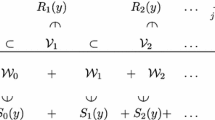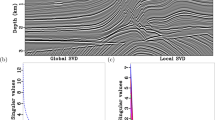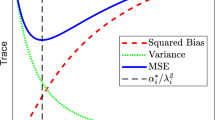Abstract
The iteratively re-weighted least squares (IRLS) is a commonly used algorithm which has received significant attention in geophysics and other fields of scientific computing for regularization of discrete ill-posed problems. The IRLS replaces a difficult optimization problem by a sequence of weighted linear systems. The optimum solution of the original problem is usually determined by computing the solution for various regularization parameters λ, each needing several re-weighted iterations (usually 10–15). In this paper, in order to decrease the required computation time (iterations) while maintaining good properties of the algorithm such as edge-preserving, the IRLS is augmented with a refinement strategy and the value of λ is progressively updated in a geometrical form during the iterations. The new algorithm, called iteratively re-weighted and refined least squares (IRRLS), can be interpreted as a Landweber iteration with a non-stationary shaping matrix which is updated based on the solution obtained from previous iteration. Two main properties of IRRLS are (1) the regularization parameter is the stopping iteration and (2) it is equipped with a tuning parameter which makes it flexible for recovering models with different smoothness. We show numerically that both the residual and regularization norms are monotone functions of iteration and hence well behaved for automatic determination of stopping parameter. The Stain’s unbiased risk estimate (SURE), generalized cross validation (GCV), L-curve analysis, and discrepancy principle (DCP) techniques are employed for automatic determination of optimum iteration. Experimental results from seismic deconvolution and seismic tomography are included showing that the proposed methodology outperforms the conventional IRLS with significantly lower computational burden.
Similar content being viewed by others
References
Charbonnier, P., Blanc-Feraud, L., Aubert, G., Barlaud, M.: Deterministic edge-preserving regularization in computed imaging. IEEE Trans. Image Process. 6, 298–311 (1997)
Chen, S., Donoho, D.L., Saunders, M.: Atomic decomposition by basis pursuit. SIAM J. Sci. Comput. 20, 33–61 (1998)
Daubechies, I., DeVore, R., Fornasier, M., Gunturk, S.: Iteratively re-weighted least squares minimization for sparse recovery. Commun. Pure Appl. Math. 63, 1–38 (2010)
Donoho, D.L.: Nonlinear solution of linear inverse problems by wavelet-vaguelette decomposition. Appl. Comput. Harmon. Anal. 2, 101–126 (1995)
Elfving, T., Nikazad, T.: Stopping rules for landweber-type iteration. Inverse Prob. 23, 1417–1432 (2007)
Farquharson, C.G., Oldenburg, D.W.: Non-linear inversion using general measures of data misfit and model structure. Geophys. J. Int. 134, 13–27 (1998)
Gheymasi, H.M., Gholami, A.: A local-order regularization for geophysical inverse problems. Geophys. J. Int. 195, 1288–1299 (2013)
Gholami, A., Hosseini, S.M.: A general framework for sparsity-based denoising and inversion. IEEE Trans. Signal Process. 59(11), 5202–5211 (2011)
Gholami, A., Hosseini, S.M.: A balanced combination of tikhonov and total variation regularizations for reconstruction of piecewise-smooth signals. Signal Process. 93, 1945–1960 (2013)
Gholami, A., Sacchi, M.D.: A fast and automatic sparse deconvolution in the presence of outliers. IEEE Trans. Geosci. Remote Sens. 50(10), 4105–4116 (2012)
Gholami, A., Siahkoohi, H.R.: Regularization of linear and non-linear geophysical ill-posed problems with joint sparsity constraints. Geophys. J. Int. 180, 871–882 (2010)
Girard, D.A.: A fast monte-carlo cross-validation procedure for large least squares problems with noisy data. Numer. Math. 56 (1989)
Hanke, M., Groetsh, C.W.: Nonstationaty iterated tikhonov regularization. J. Optim. Theory Appl. 98, 37–53 (1998)
Hansen, P.C.: Analysis of discrete ill-posed problems by means of the l-curve. SIAM Rev. 34(4), 561–580 (1992)
Hansen, P.C.: Rank-deficient and discrete Ill-posed problems: Numerical aspects of linear inversion. SIAM, Philadelphia (1999)
Hutchinson, M.F.: A stochastic estimator for the trace of the influence matrix for Laplacian smoothing splines. Comput. Stat.—Simul. Comput. 19(2), 433–450 (1990)
Landweber, L.: An iteration formula for Fredholm integral equations of the first kind. Amer. J. Math. 73, 615–624 (1951)
Lawson, C.L.: Contributions to the theory of linear least maximum approximation. Ph.D. thesis, University of California, Los Angeles (1961)
Levy, S., Fullager, P.K.: Reconstruction of a sparse spike train from a portion of its spectrum and application to high-resolution deconvolution. Geophysics 49, 1235–1243 (1981)
Mayer, C.D.: Matrix analysis and applied linear algebra. SIAM, Philadelphia (2001)
Morozov, V.: The solution of functional equations by the method of regularization. Soviet Math. Dokl 7(4), 414–417 (1966)
Ramani, S., Liu, Z., Rosen, J., Nielsen, J.F., Fessler, J.A.: Regularization parameter selection for nonlinear iterative image restoration and MRI reconstruction using GCV and SURE-based methods. IEEE Trans. Image Process. 21(8), 3659–3672 (2012)
Rudin, L.I., Osher, S., Fatemi, E.: Nonlinear total variation based noise removal algorithms. Phys. D 60, 259–268 (1992)
Scales, J.A.: Tomographic inversion via the conjugate gradient method. Geophysics 52, 179–185 (1987)
Strand, O.N.: Theory and methods related to the singular-function expansion and landweber’s iteration for integral equations of the first kind. SIAM J. Numer. Anal 11, 798–825 (1974)
Succhi, M.D.: Reweighting strategies in seismic deconvolution. Geophys. J. Int. 129, 651–656 (1997)
Taylor, H.L., Banks, S.C., McCoy, J.F.: Deconvolution with the l p -norm. Geophysics 66, 39–52 (1979)
Tikhonov, A.N., Arsenin, V.Y.: Solutions of Ill-posed problems. Winston and Sons, Washington (1977)
Vogel, C.R.: Computational methods for inverse problems. SIAM, Philadelphia (2002)
Wahba, G.: Practical approximate solution of linear operator equations when the data are noisy. SIAM J. Numer. Anal. 14(4), 651–667 (1997)
van Wijk, K., Scales, J.A., Navidi, W., Tenorio, L.: Data and model uncertainty estimation for linear inversion. Geophys. J. Int. 149, 625–632 (2002)
Author information
Authors and Affiliations
Corresponding author
Rights and permissions
About this article
Cite this article
Gholami, A., Mohammadi Gheymasi, H. Regularization of geophysical ill-posed problems by iteratively re-weighted and refined least squares. Comput Geosci 20, 19–33 (2016). https://doi.org/10.1007/s10596-015-9544-1
Received:
Accepted:
Published:
Issue Date:
DOI: https://doi.org/10.1007/s10596-015-9544-1




